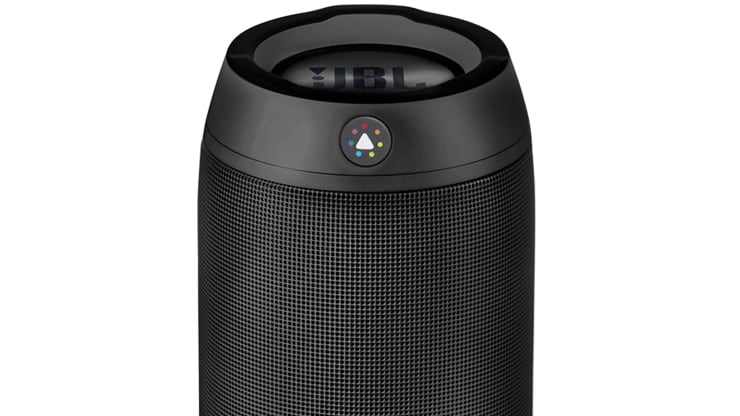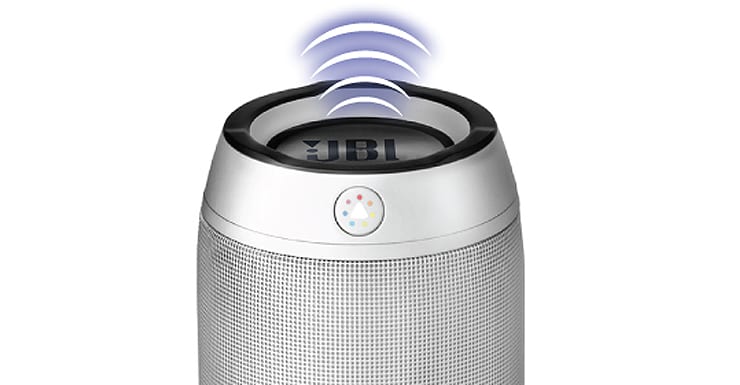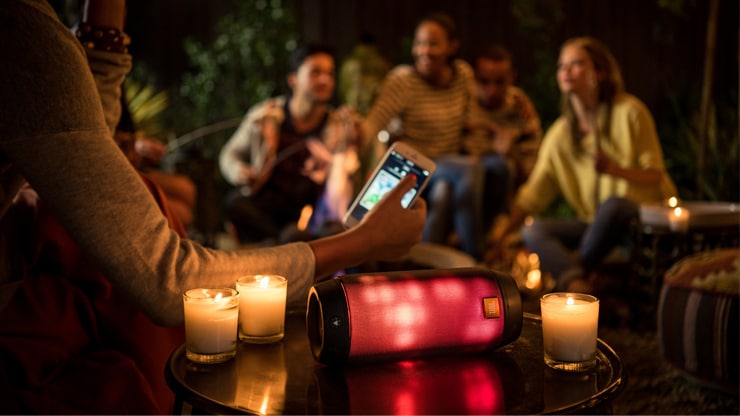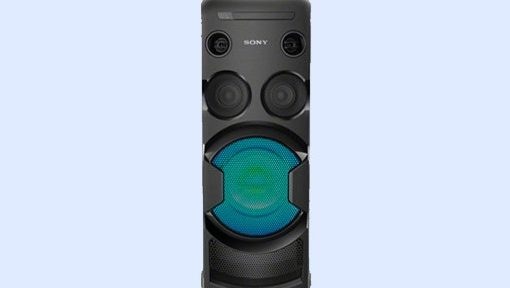When it comes to making stylish speakers, JBL is one of the first names that comes to mind. Their portable speaker, the Pulse has been the perfect example of that. With colourful LEDs embedded around its cylindrical body, it wasn’t just meant to be an exceptional speaker, but also eye-candy. Now, we have the Pulse 2, a bigger, even flashier speaker. It has more power in terms of audio and a lot more lighting features to play around with. It’s priced at just under Rs. 15,000. Let’s find out if it performs as good as it looks.
Design and build
It looks like all of JBL’s next generation Bluetooth speakers are getting bigger in size. We’ve reviewed the Flip 3 and Charge 2, which were both bigger than their predecessors. The Pulse 2 is no exception. In fact, the Pulse 2 is remarkably bigger than previous variant and other portable speakers from JBL. It measures 194mm in width and also weighs about 775g, making it a lot less handy than the previous Pulse. To give you a better idea, the speaker fits right between the JBL Xtreme and Charge 2+. You can hold and carry the speaker in one hand, but it won’t be easy, especially if you have small hands. Don’t be surprised either if the Pulse 2 ends up taking all the space in your hand bag.

The Pulse 2 might be less portable than its predecessor, but that doesn’t mean it’s not made for outdoors. It has a solid build, something you would immediately notice when you hold the speaker. A metal grill runs all around the body. Underneath the grill are the LEDs. The edges on the side and the area around the buttons have a matte finish coating, which provides the much needed grip.

The outer rings of the edges are covered with a thick rubber padding, which will certainly prevent the speaker from getting damaged, if you ever happen to drop it. These pads also act like a good stand for the Pulse 2, when you place the speaker vertically. The best thing about the design is that it is splashproof. You can take it out carelessly on rainy days or by your poolside. You can even use water to clean the speaker, but JBL strictly warns you from submerging the speaker in it.  In essence, the Pulse 2 is designed like Charge 2+ and Flip 3. It has two bass reflectors on both sides and a similar button placement. All the buttons on the speakers are embedded within the matte finish. The list includes a Power button, a Bluetooth button, Volume keys, Play/Pause button and an additional light button, to control the light effects. Next to them are the five LEDs that indicate the charge. The 3.5mm auxiliary jack and the micro USB port are protected by a thick flap, which isn’t very easy pull out. A light sensor is also placed here but we’ll talk about it in the next section.
In essence, the Pulse 2 is designed like Charge 2+ and Flip 3. It has two bass reflectors on both sides and a similar button placement. All the buttons on the speakers are embedded within the matte finish. The list includes a Power button, a Bluetooth button, Volume keys, Play/Pause button and an additional light button, to control the light effects. Next to them are the five LEDs that indicate the charge. The 3.5mm auxiliary jack and the micro USB port are protected by a thick flap, which isn’t very easy pull out. A light sensor is also placed here but we’ll talk about it in the next section.
Features
The JBL Pulse 2 boasts of the same specifications as the Charge 2+. It sports two 45mm drivers that JBL promises have a frequency response from 85Hz to 20kHz. The bass reflectors are known to offer good lows. It also comes with the same 6,000 mAh battery that JBL claims will last for 10 hours of music playback. The battery is estimated to charge completely in 5 hours, which sounds like a lot. The speaker can be charged via a micro USB cable, which is included in the box.  The JBL Pulse 2 supports Bluetooth 4.1. It can connect up to three devices at the same time. It’s a good feature to have, as you can control the music from different devices and not have go through the hassle of connecting and disconnecting all the time. Like all the latest JBL speakers, the Pulse 2 also supports JBL Connect. This feature allows you to connect the Pulse 2 to other JBL speakers that supports this feature. Once connected, they can be used as dual mono speakers to enhance the audio performance. If you happen to have two Pulse 2, then you can use them as stereo speakers as well.
The JBL Pulse 2 supports Bluetooth 4.1. It can connect up to three devices at the same time. It’s a good feature to have, as you can control the music from different devices and not have go through the hassle of connecting and disconnecting all the time. Like all the latest JBL speakers, the Pulse 2 also supports JBL Connect. This feature allows you to connect the Pulse 2 to other JBL speakers that supports this feature. Once connected, they can be used as dual mono speakers to enhance the audio performance. If you happen to have two Pulse 2, then you can use them as stereo speakers as well.  The LEDs on the Pulse 2 can display a wide range of colours in different variations. The idea is to set the mood in order to match the ambience. There are nine pre-programmed modes to choose from. Most of the modes are designed for outdoor settings. The most basic ones is the equaliser mode, which works as the equalisers seen on music players. The LEDs here react to the highs and lows of the song playing on the speaker. Other modes include Rain, Fireflies, Stars, Canvas, Traffic, Hourglass and Fireworks. We tried all of them and found them to be refreshing. You can switch between modes using the button on the speaker or with the help of the JBL Connect app.
The LEDs on the Pulse 2 can display a wide range of colours in different variations. The idea is to set the mood in order to match the ambience. There are nine pre-programmed modes to choose from. Most of the modes are designed for outdoor settings. The most basic ones is the equaliser mode, which works as the equalisers seen on music players. The LEDs here react to the highs and lows of the song playing on the speaker. Other modes include Rain, Fireflies, Stars, Canvas, Traffic, Hourglass and Fireworks. We tried all of them and found them to be refreshing. You can switch between modes using the button on the speaker or with the help of the JBL Connect app.  There are plenty of other features added to the lights. You can explore them in the JBL Connect app. You can change the intensity of different modes using your smartphone. The lights also reacts to the noise around it. The built-in microphone detects sound and changes the intensity of the lights based on the ambient sound. If you want to impress somebody instantly, you can also shake the speakers to see a 10 second animations pop-up on the lights. However pretty, these features come across as a party piece for the Pulse 2.
There are plenty of other features added to the lights. You can explore them in the JBL Connect app. You can change the intensity of different modes using your smartphone. The lights also reacts to the noise around it. The built-in microphone detects sound and changes the intensity of the lights based on the ambient sound. If you want to impress somebody instantly, you can also shake the speakers to see a 10 second animations pop-up on the lights. However pretty, these features come across as a party piece for the Pulse 2.  The most surprising thing about the Pulse 2 though, is the Colour sensor lens added to it. Here, the sensor looks at the colours present around it and tries to match the lights on-board the speaker. JBL has included a Prism button that acts like the shutter for lens, just like a camera. It looks very interesting. Instead of letting you choose a colour individually from the app, JBL wants you to point-and-shoot at the colours you prefer in the moment.
The most surprising thing about the Pulse 2 though, is the Colour sensor lens added to it. Here, the sensor looks at the colours present around it and tries to match the lights on-board the speaker. JBL has included a Prism button that acts like the shutter for lens, just like a camera. It looks very interesting. Instead of letting you choose a colour individually from the app, JBL wants you to point-and-shoot at the colours you prefer in the moment.
Performance
As suspected the Pulse 2 sounds a bit similar to Charge 2, we had reviewed earlier. When it comes to bass response, the Pulse 2 is a bit better though. It has much deeper bass. However, on the Charge 2, the audio output is crisp, when it comes to punchy bass. The mids on the Pulse 2 are good, but the upper mids sound a bit flat. They slide a little to the lower side and as a result, aren’t very clear. It is noticeable on high volumes. Overall, we still think the JBL Pulse 2 sounds good. It’s just about right, for indoors and outdoors. One of the first tracks we played on the Pulse 2 was Ed Sheeran’s, ‘Give me love’. We liked the melodic start of the song. It sounded quite pleasant. The guitar sounded very clean and up to par with Ed Sheeran’s vocals. However, the speaker seemed to lose detail, once the song kicked up the tempo at the beginning of the fourth minute. It was mostly because of the overhyped bass. The clapping that follows next didn’t sound very crisp either. The speaker did justice to the vocals though; they sounded consistent throughout. We also tried the Pulse with some heavy complex songs. We played Vertigo from Deafheaven. This instrumental song is heavy and the Pulse managed to present it really well. There was no distortion, even on high volumes. Unfortunately, we had the same problem as with other tracks. The bass tries to overcompensate too much and in the process, hampers the sharpness of the song. It was more prominent once the heavy distortions in the song kicked-in, in the third minute. Even with the distortion, we could hear all the instruments clearly. The guitar riffs sounded pretty good, as did the cymbals. It’s just that there was too much bass around it, which made the background sound a bit gushy. We tried an electronic artist, Four Tet. We heard ‘Unspoken’ and liked the performance. It was room filling. With so much going on in the song, the Pulse 2 captured every piece of it very clearly. Everything from the heavy drum beats to the soothing chimes were quite clear. The drums did fall a little flat, but it was covered by other elements in the song and was overall fun to listen to.
One of the first tracks we played on the Pulse 2 was Ed Sheeran’s, ‘Give me love’. We liked the melodic start of the song. It sounded quite pleasant. The guitar sounded very clean and up to par with Ed Sheeran’s vocals. However, the speaker seemed to lose detail, once the song kicked up the tempo at the beginning of the fourth minute. It was mostly because of the overhyped bass. The clapping that follows next didn’t sound very crisp either. The speaker did justice to the vocals though; they sounded consistent throughout. We also tried the Pulse with some heavy complex songs. We played Vertigo from Deafheaven. This instrumental song is heavy and the Pulse managed to present it really well. There was no distortion, even on high volumes. Unfortunately, we had the same problem as with other tracks. The bass tries to overcompensate too much and in the process, hampers the sharpness of the song. It was more prominent once the heavy distortions in the song kicked-in, in the third minute. Even with the distortion, we could hear all the instruments clearly. The guitar riffs sounded pretty good, as did the cymbals. It’s just that there was too much bass around it, which made the background sound a bit gushy. We tried an electronic artist, Four Tet. We heard ‘Unspoken’ and liked the performance. It was room filling. With so much going on in the song, the Pulse 2 captured every piece of it very clearly. Everything from the heavy drum beats to the soothing chimes were quite clear. The drums did fall a little flat, but it was covered by other elements in the song and was overall fun to listen to.  The LEDs though not very useful, do enhance your experience. The best place to use them is under dim lighting. All the modes are fairly appealing. In the Equaliser mode, the lights do not respond accurately to the music, but it’s not something you’d notice very easily, with the colour constantly changing. We found other modes like Rain and Fire also quite appealing. When it comes to functionality, the Hourglass is the only mode that you might actually find some use for, while playing games with your friends. The Canvas mode lets you draw something on your smartphone, which is then reflected on the speaker. It’s not useful as such, but it’s still fun to play around with.
The LEDs though not very useful, do enhance your experience. The best place to use them is under dim lighting. All the modes are fairly appealing. In the Equaliser mode, the lights do not respond accurately to the music, but it’s not something you’d notice very easily, with the colour constantly changing. We found other modes like Rain and Fire also quite appealing. When it comes to functionality, the Hourglass is the only mode that you might actually find some use for, while playing games with your friends. The Canvas mode lets you draw something on your smartphone, which is then reflected on the speaker. It’s not useful as such, but it’s still fun to play around with.  The Prism colour lens looks more like a novelty, but it does work. To get the right colour you have to pretty much stick the speaker to the surface you want to replicate. Most instances, it worked quite well. The colours weren’t very accurate but we weren’t betting on it either. Pointing it to a reflective surface won’t work that well. Regardless, it’s still fun to use than just choosing a random colour from the app. JBL claims that the microphone on the Pulse is used for both, noise and echo cancelling, allowing you to have crystal-clear voice calls. We put it to the test. Calls we made with the help of the speaker were clear. We found it comfortable to talk even from a distance of 3 feet. The microphone does a good job of eliminating background noise around it. In our calls, the voice in the front was well isolated from the loud music playing in the background, which was quite impressive.
The Prism colour lens looks more like a novelty, but it does work. To get the right colour you have to pretty much stick the speaker to the surface you want to replicate. Most instances, it worked quite well. The colours weren’t very accurate but we weren’t betting on it either. Pointing it to a reflective surface won’t work that well. Regardless, it’s still fun to use than just choosing a random colour from the app. JBL claims that the microphone on the Pulse is used for both, noise and echo cancelling, allowing you to have crystal-clear voice calls. We put it to the test. Calls we made with the help of the speaker were clear. We found it comfortable to talk even from a distance of 3 feet. The microphone does a good job of eliminating background noise around it. In our calls, the voice in the front was well isolated from the loud music playing in the background, which was quite impressive.
Verdict
Overall, the JBL Pulse 2 is meant to be a pleasing speaker both visually and audibly, which we think it is. We wouldn’t recommend it to an audiophile though. The Pulse 2 makes a great outdoor speaker. It’s loud enough to play music to host an outdoor party. Added to that, it looks great, has a sturdy build and is splashproof. If you can overlook audio performance by a bit, but want all the features in a portable speaker, then by all means, get the Pulse 2.



